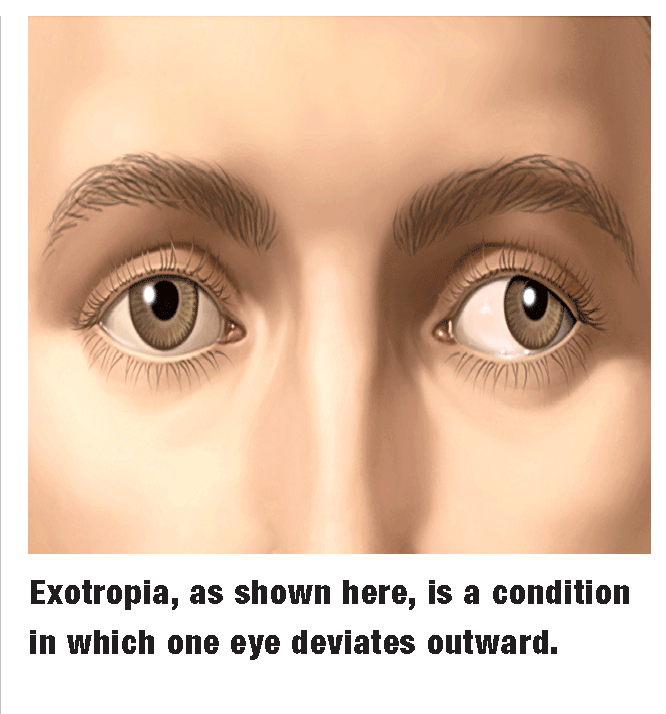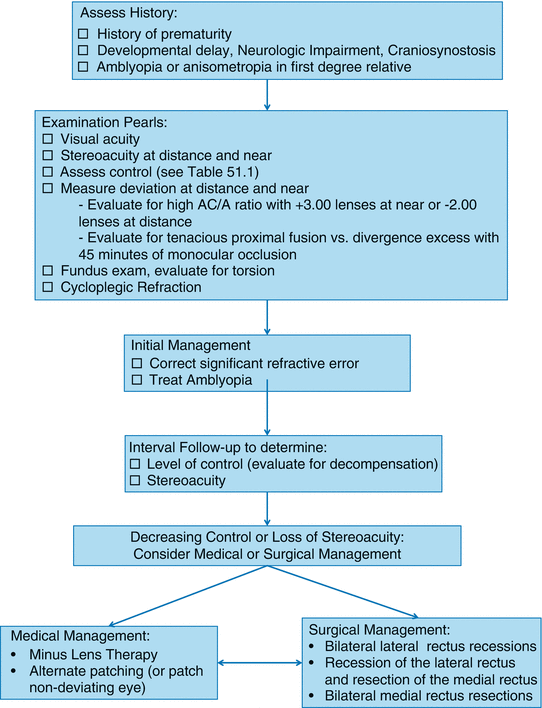Background The clinical management of intermittent exotropia has been discussed extensively in the literature, yet there remains a lack of clarity regarding indications for intervention, the most effective form of treatment and whether or not there is an optimal time in the evolution of the disease at which any treatment should be carried outEsotropia is a form of strabismus (eye misalignment) characterized by an inwards turn of one or both eyes See figure 1 It may be intermittent or constant and may occur with near fixation, distance fixation, or both The crossing may occur mostly with one eye or may alternate between eyes Esotropia may occur at any age and is the opposite ofSome people develop esotropia, while others might develop eyes that turn outward instead (exotropia) According to the College of Optometrists in Vision Development ,

A Randomized Trial Comparing Part Time Patching With Observation For Intermittent Exotropia In Children 12 To 35 Months Of Age Ophthalmology
Treatment for alternating exotropia
Treatment for alternating exotropia-Alternating Exotropia Presentation Subjects were instructed to make saccades between two continuously lit targets (LED's) presented in an isovergence array (with the straightahead target 130 cm from the eyes) in a dimly lit room Exotropia with neurologic causes and field defects Exotropia with bilateral homonymous visual field defects Nonsurgical methods of treatment, such as patching, prisms, or botulinum toxin injections, should be tried before surgical realignment Exotropia with bitemporal visual field defects Nonsurgical treatment includes the use of prisms to




Strabismus Pdf Ophthalmology Clinical Medicine
Exotropia or exoforia Exotropia is a defect that occurs when the eyes are turned outward, which causes a major blurred vision problemExophoria is a type of strabismus and is also known colloquially as wall eyes The exophoria can be congenital o acquired and it is more common in women than in men If the condition is mild, it may go away on its own within 6 to 8 weeks of birth In other cases of exotropia, it is not common to find a complete resolution of the condition While patching, glasses, or vision therapy can help, exotropia may remain presentExotropia is a type of strabismus, which is a misalignment of the eyes Exotropia is a condition in which one or both eyes turn outward away from the nose
Treatment of intermittent exotropia Intermittent exotropia should be treated immediately, as any misalignment indicates that the eyebrain connection is not working effectively The most successful treatment for strabismus is vision therapy, usually with other means such as eye patching, eyeglasses, and surgeryCase 1 Intermittent alternating exotropia of the basic type, severe accommodative insufficiency and anisometropia Case 2 Intermittent alternating exotropia of the basic type, and mild accommodative infacility Basic exotropia results when the exotropia has approximately the same magnitude and frequency at distance and nearNear stereopsis improved significantly after 9 months of treatment (p = 0043) Conclusion Alternate occlusion is significantly effective on control of intermittent exotropia As a result, it can be used as a useful method to postpone or even eliminate the need for surgery in
Depends on severity treatment for alternating exotropia includes observation, patching, glasses, penalization with Atropine, exercises, and surgeryit all depends on how Read More In another retrospective analysis by Figueira 43 that aimed to identify the best treatment option for intermittent exotropia, it was reported that surgery combined with preoperative orthoptic/occlusion therapy achieved the highest successful treatment rate at the 5 year followup (846%) when compared to surgery alone (25%) Success was definedIn each eye through moderate myopic prescription Cover test showed 10∆ intermittent alternating exotropia with 6∆ left hypertropia at far and near, present about 80% of the time Worth 4dot testing revealed diplopia at 6 feet and intermittent fusion at 16 inches Stereopsis was 50" with () random dot forms




Pdf Very Rapid Alternate Occlusion As A Treatment For Suppression In Intermittent Exotropia




Lazy Eyes Alternating Exotropia Strabismus Youtube
Staying as healthy as possible may also help Feeling sick or having a fever may cause the intermittent exotropia to temporarily occur more frequently Intermittent exotropia is the most common type of exotropia in children Treatment options are surgical and non surgical Nonsurgical management include Correction of refractive errors, Active orthoptic treatments, Prisms and Occlusion therapy Benefits of patch therapy are limiting suppression, reducing the frequency and amplitude of theThe goal of the prescribed treatment regimen is to address the diagnostic factors and alleviate the presenting signs and symptoms associated with the diagnosed condition The treatment of alternating comitant exotropia requires the use of optometric vision therapy, which may include the use of lenses and/or prisms




Everything You Need To Know About Cover Testing Eyedolatry




Grace S Outward Turned Eye Family Eyecare
Engaging patients (parents/families) in treatment decisions is increasingly recognised as important and beneficial Yet where the evidence base for treatment options is limited, as with intermittent distance exotropia (X(T)), this presents a challenge for families and clinicians The purpose of this study was to explore how decisions are made in the managementHypertropia is a type of strabismus, also known as misalignment of the eyes Hypertropia happens when either eye drifts or looks upward Infants' eyes usually align by the age of 2 to 3 months, even if the eyes seem to wander in newborns Hypertropia that continues or develops after that age can cause "Lazy eye" (amblyopia) Inability of the A multicenter, randomized, controlled trial assessed the role of patching in children aged 3 to 10 years with intermittent exotropia 36 Children were randomized to observation versus 6 months of 3 hours of daily patching (1 eye or alternating eyes, at the prescriber's discretion) At 6 months, rate of deterioration in both groups was low, suggesting that both observation and




Do You See A Pattern




How To Fix Exotropia 9 Steps With Pictures Wikihow
Most studies of intermittent exotropia deal primarily with children However, the manifestations of this disorder in adults differ considerably from those in children The case records of 44 adults (ages 1570) who underwent surgery for intermittentCommon sense approaches may help to control intermittent exotropia For example, getting the recommended amount of sleep for age is important—many children don't!• constant, alternating esotropia (90% OD) • intermittent suppression of binocular vision • iatrogenic hyperopia secondary to cataract surgery Maria knew that vision therapy was her treatment of choice She strongly believed that surgery should only be a last resort




Management Of Intermittent Exotropia Of The Divergence Excess Type A Teaching Case Report The Journal Of Optometric Education



1
Treatment options for exotropia are not always the same There are a variety of treatments for exotropia that include surgical correction, vision therapy, prism, or corrective lenses It is important to recognize that not all treatments are curing an exotropiaAs explained above, the same options of nonsurgical treatment in the form of hypermetropic correction, bifocals, or prismotherapy might be considered Any decision for repeat surgery should only be after 6 months postsurgery Residual ExotropiaHow is exotropia treated?




Vision Therapy For Intermittent Exotropia A Case Series Journal Of Optometry




Management Of Squint With Near Distance Angle Disparity Eye News
Advantages and disadvantages of other treatment options are also discussed Key Words divergence excess, intermittent exotropia, overminus therapy, AC/A ratio, vision therapy Background Intermittent exotropia (IXT) is the most common form of childhood exotropia1, 2 with an incidence of 321 per 100,000 inEsotropia is a condition that causes the eyes to turn inward It can emerge during the first year of life, or it may appear in adulthood as a result of an underlying condition, such as diabetes Exotropia Exotropia is when the eyes are pointed away from each other and this is present at all times Alternating means that the deviation switches from one eye to the other This is a common finding and in many cases does not require any treatment




Strabismus Amblyopia Neuro Vision Development Center




Strabismus Long Island Ny Crossed Eyes Sightmd
Treatment for exotropia depends on how often you have symptoms and on how severe they are Prism in your glasses may be prescribed to help with double vision Eye muscle surgery is also an option, especially if your exotropia isEsotropia is a strabismus condition where the eye turns inward (toward the nose) This condition may be evident intermittently (not all the time) or constantly The deviation, or eye turn, may occur while fixating (looking at) distance objects, near objects, orExotropia Exotropia, commonly called wandering eye or walleye, is the visual condition in which a person uses only one eye to look at an object while the other eye turns outward Exotropia is one of several types of strabismus, a condition resulting in eye turns or deviating eyes This condition usually does not involve faulty or damaged eye




How Successful Are Non Surgical Treatments For Alternating Exotropia Eye And Vision Sharecare




Exotropia Outward Deviation Of The Eye Prosper Family Eyecare And Vision Development Center
Alternating exotropia refers to how a patient fixates A patient with a constant exotropia of one eye fixates with the same eye all the time This would be called unilateral (right or left) exotropia Exotropia is a type of strabismus characterised by outward deviation of an eye If Exotropia affects both eyes, as a result of which the individual is unable to align both eyes, the condition is termed as convergence insufficiency or exophoria Know the causes, symptoms, treatment, prognosis and complications of exotropia Vision therapy (VT) is a commonly prescribed treatment for children with intermittent exotropia (IXT) The effectiveness of VT as a treatment modality for children with IXT is unknown because previous studies have largely limited observational or retrospective case series without comparison groups




How To Fix Exotropia 9 Steps With Pictures Wikihow




Pdf The Use Of The Newcastle Control Score In The Management Of Intermittent Exotropia
Treatment of intermittent exotropia Treatment recommendations depends on the severity of the problem, on the signs and symptoms, and on the patient and family desires When the drifting eye movement is mild, observation may be all that is needed Sometimes, the condition will remain the same over a long period of time or may even get better Esotropia DefinitionPage Contents1 Esotropia Definition2 Esotropia Synonyms3 Esotropia Types4 Esotropia Symptoms5 Esotropia Causes6 Esotropia Diagnosis7 Esotropia Treatment8 Esotropia Prognosis Esotropia is a form of ocular motility disorder that can begin as early as infancy, or even in later adulthood Individuals with this condition normally have a squint,Exotropia is a common type of strabismus that occurs when misaligned eyes deviate outward Exotropia (also known as walleye or divergent strabismus) differs from its opposite form, esotropia (eye turns in toward nose), in that exotropic eyes point outward or away from the nose Exotropia can occur in one or both eyes



V Pattern Exotropia American Academy Of Ophthalmology




Pdf Surgical Management Of Intermittent Exotropia Do We Have An Answer For All
Background Intermittent exotropia (IXT) is the most common form of childhood exotropia 1, 2 with an incidence of 321 per 100,000 in children under 19 years of age 1 The strabismus is characterized by an exodeviation of one eye that is interspersed with periods of ocular alignment 3 Reliable measurement of the deviation is often hindered by the variable nature of the strabismus,Treatment of Intermittent Exotropia Treatment options consist of Vision Therapy, patching, eyeglasses and/or, very rarely, surgery The most successful form of treatment is inoffice supervised Vision Therapy with home reinforcement Therapy changes the brain and is directed at the cause and cure of the problemTreatment for esotropia and exotropia aims to ensure proper vision in both eyes and straighten the eyes Among the treatment options for esotropia are Glasses to correct vision problems such as nearsightedness, farsightedness or astigmatism Patching of the good eye, to improve vision in the lazy (amblyopic) eye



Co Patterns In Striate Cortex In Exotropia A C Alternating Light And Download Scientific Diagram



V Patterns Esotropia And Exotropia And Their Management By Dr Sudhir Singh
OPTOMETRIC CLINICAL PRACTICE GUIDELINE CARE OF THE PATIENT WITH STRABISMUS ESOTROPIA AND EXOTROPIA Reference Guide for Clinicians Prepared by the American Optometric Association Consensus Panel




What Is Intermittent Strabismus Optometrists Org




Strabismus Exotropia Esotropia Cover Test Geeky Medics




Exotropia Types Symptoms Diagnosis Treatment Prevention




Home Exercises For 7 Year Old With Intermittent Alternating Exotropia Strabismus




Intermittent Xt




Woman Presents With Worsening Diplopia




Management Of Intermittent Exotropia Of The Divergence Excess Type A Teaching Case Report The Journal Of Optometric Education




What About The Exophores Myopia Profile Binocular Vision Myopia Control




Management Of Exotropia In Childhood Springerlink




Constant Exotropia Management Youtube




Management Of Intermittent Exotropia Of The Divergence Excess Type A Teaching Case Report The Journal Of Optometric Education




Strabismus Pdf Ophthalmology Clinical Medicine



Vision Therapy For Intermittent Exotropia A Case Series Journal Of Optometry




Vision Therapy For Intermittent Exotropia A Case Series Journal Of Optometry




Exotropia In Children And Adults




Exotropia American Association For Pediatric Ophthalmology And Strabismus




Surgery For Concomitant Esotropia And Exotropia Opth




Exotropia Ento Key




Ask Dr Julie Can You Treat Alternating Strabismus Youtube



Exotropia




Exotropia Outward Eye Turn




Pdf Optometric Vision Therapy In The Management Of Consecutive Intermittent Exotropia With Dissociated Vertical Deviation And Anomalous Correspondence A Case Study Semantic Scholar




Exotropia Pediatric Ophthalmic Consultants




Exotropia




Intermittent Exotropia




Exotropia Outward Eye Turn




What Is Exotropia Vision Express




Sizing Up Strabismus




Non Surgical Management Options Of Intermittent Exotropia A Literature Review Heydarian S Hashemi H Jafarzadehpour E Ostadi A Yekta A Aghamirsalim M Dadbin N Ostadimoghaddam H Khoshhal F Khabazkhoob M J Curr




3 Eye Exercises For Strabismus Healthline



2




Strabismus Amblyopia Leukocoria Saeed Alwadani Md Assistant Professor




Management Of Squint With Near Distance Angle Disparity Eye News




A Nail In The Coffin Of Over Minus Lens Treatment For Intermittent Exotropia The Visionhelp Blog




Pdf A Pilot Randomized Trial Evaluating Overminus Spectacles Versus Part Time Occlusion For Control Of Intermittent Exotropia Among Children 2 10 Years Of Age




Exotropia Types Symptoms Diagnosis Treatment Prevention




Exotropia Eyewiki




Role Of Overminus Therapy In Intermittent Exotropia Mangad Se Mohan L Vijayalakshmi M S Krishnan P Babu Sp Kerala J Ophthalmol




Management Of Intermittent Exotropia Of The Divergence Excess Type A Teaching Case Report The Journal Of Optometric Education




Exotropia American Association For Pediatric Ophthalmology And Strabismus




Exotropia Ento Key




What Is Exotropia Causes Symptoms Treatment Prognosis Complications




How To Fix Exotropia 9 Steps With Pictures Wikihow



Alternating Exotropia Disease Malacards Research Articles Drugs Genes Clinical Trials




Management Of Intermittent Exotropia Of The Divergence Excess Type A Teaching Case Report The Journal Of Optometric Education




Exotropia Types Symptoms Diagnosis Treatment Prevention




Your Stories Intermittent Exotropia And Conflicting Treatment Options For Little Eyes




Testing Children For Accommodative And Convergence Disorders




Strabismus Screening Now There S An App For That



Dos Jul 17 Flip Ebook Pages 1 50 Anyflip Anyflip




Management Of Intermittent Exotropia Of The Divergence Excess Type A Teaching Case Report The Journal Of Optometric Education




Neuromuscular Disease Esotropia




Cortical Metabolic Activity Matches The Pattern Of Visual Suppression In Strabismus Journal Of Neuroscience




Intermittent Exotropia Ento Key



1




How To Fix Exotropia 9 Steps With Pictures Wikihow




Vision Therapy Success Story Strabismus Exotropia Eye Turn Outward Vision Therapy Philippines




Jaypeedigital Ebook Reader




Video Of My Intermittent Alternating Exotropia Strabismus




Management Of Intermittent Exotropia Of The Divergence Excess Type A Teaching Case Report The Journal Of Optometric Education




Exotropia Outward Eye Turn




Exotropia Eyes Turn Outward Causes Symptoms Treatment Vision Center



Alternating Exotropia American Academy Of Ophthalmology



3



Divergent Squint Dr Ramesh Murthy




Intermittent Xt




Exotropia Definition Categories Treatment



2




Vision Therapy For Intermittent Exotropia A Case Series Journal Of Optometry




Exophoria




Conservative Management Of Intermittent Exotropia To Defer Or Avoid Surgery The Visionhelp Blog




Pdf Orthoptic Treatment In The Management Of Intermittent Exotropia




A Randomized Trial Comparing Part Time Patching With Observation For Intermittent Exotropia In Children 12 To 35 Months Of Age Ophthalmology




How To Fix Exotropia 9 Steps With Pictures Wikihow




Alternating Comitant Exotropia




Intermittent Distance Exotropia Hull University Teaching Hospitals Nhs Trust




Exotropia Pre And Post Surgical Pictures Youtube



Do People With Exotropia Outward Facing Strabismus Have A Wider Field Of Vision And If So Isn T This More Useful Than The Normal Human Range Quora



Alternating Exotropia Disease Malacards Research Articles Drugs Genes Clinical Trials




Non Accommodative Esotropia And Botulinum Toxin Therapy




Jaypeedigital Ebook Reader




How To Fix Exotropia 9 Steps With Pictures Wikihow




Management Of Intermittent Exotropia Of The Divergence Excess Type A Teaching Case Report The Journal Of Optometric Education




Esotropia Alternating And Intermittent Types And Treatment Options



0 件のコメント:
コメントを投稿